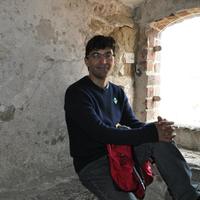Papers by Kristiina Mannermaa
Eläimistön varhaisvaiheita voidaan seurata jääkauden päättymisestä lähtien
Berguvens födoval i skärgårdsmiljö
Mannermaa, K. 2004. Muinaisen Itämeren lintuluulöydöt
Tietoja Saaristomeren linnuista vuosituhansien takaa
Kyhmyjoutsen alkuperäinen laji
Elämä ja kuolema Gotlannissa
Helsingin Sanomat, Jul 17, 2000
Goose: Domestication
Springer eBooks, 2014
Rannalta löytyi hevosen luu
Prehistry of dogs in Fennoscandia: A review
Hunter-gatherer prone burials of the Kubenino site, NW Russia (c. 4900 cal BC): Normative or deviant burials?

Anthropozoologica, Dec 1, 2013
Recent archaeological studies reveal the importance of birds in prehistoric North-European hunter... more Recent archaeological studies reveal the importance of birds in prehistoric North-European hunter-fisher-gatherer burial practices. In this article I describe two examples of bird species at prehistoric hunter-gatherer burials: the Eurasian jay (Garrulus glandarius) at the Middle Neolithic Zvejnieki site in northern Latvia, and the osprey (Pandion haliaetus) at the Late Mesolithic Yuzhniy Oleniy Ostrov site in western Russia. I suggest that the bone finds and their archaeological contexts indicate a prehistoric ideology that can be interpreted as representing totemism and shamanism. The wing bones had a specific function and meaning, probably connected to protection, transformation or transport. The deposition of osprey legs may indicate that the power of this bird was particularly appreciated and re-mobilized in the burial. RÉSUMÉ Le pouvoir des oiseaux : le geai des chênes (Garrulus glandarius) et le balbuzard pêcheur (Pandion haliaetus) dans les tombes de chasseurs cueilleurs de Zvejnieki, (Lettonie du nord) et Yuzhniy Oleniy Ostrov (Russie du nord-ouest). Les récentes recherches archéologiques ont révélé la signification des oiseaux dans les pratiques funéraires des communautés de chasseurs, cueilleurs, pêcheurs préhistoriques en Europe du nord. Cet article présente deux oiseaux qui apparaissent dans des tombes de communautés de chasseurs : le geai (Garrulus glandarius), dans les tombes du Néolithique moyen de Zvejniek situé en Lettonie du nord, et le balbuzard (Pandion haliaetus) dans les tombes mésolithiques d'Yuzhniy Oleniy Ostrov situé en Russie du nord-ouest. Je suggère dans mon article que les os de geai et de balbuzard pourraient être interprétés comme représentant un univers totémiste et chamaniste. Les os de l'aile du geai avaient une signification et une fonction particulières dans les rituels funéraires ; peut-être celles de protéger le défunt et de l'aider à atteindre l'autre monde. Symbolisant peut-être une force singulière pour les populations de la région de la Carélie, les os des pattes du balbuzard, placés dans la tombe auraient peut-être permis l'utilisation de cette force après la mort.
Environmental Archaeology, Aug 6, 2015
Historical sources, such as tax rolls and accounts, can provide information about mediaeval fishi... more Historical sources, such as tax rolls and accounts, can provide information about mediaeval fishing and fish trade, but this subject can also be investigated through archaeological methods. Archaeological research on the mediaeval and early historical fishing in Finland has not been undertaken in any detail. Research from neighbouring areas, mainly Sweden and Estonia, has provided information about mediaeval fishing in northern Europe. This paper presents the results of a osteological examination of a sample of archaeological fish bones excavated in the Old Town of Helsinki in 1993. The sample derives from the remains of a cellar in a house, used in late-sixteenth or early-seventeenth century by a wealthy person, probably a merchant.
Stone Age Rattle Reconstructed
Minne katosivat hyljekoirat
Unberto Albarella, Mauro Rizzetto, Hannah Russ, Kim Vickers & sarah Viner-Daniel (eds.): The Oxford handbook of Zooarchaeology
Aurinkoa ja alan huippuja - SAA-konferenssi Honolulussa 3.-7.4. 2013 (78th Annual Meeting of the Society for American Archaeology)
Archaeology and Analogy: Papers from the Eighth Theoretical Seminar of the Baltic Archaeologists (BASE), Held at the University of Helsinki and Tvärminne Zoological Station, Hanko, Finland, November 30th–December 2nd, 2017

Antiquity, May 26, 2020
Birds of the Bronze Age: a North European perspective takes in a geographic area including parts ... more Birds of the Bronze Age: a North European perspective takes in a geographic area including parts of modern Denmark, Norway, Sweden and the Baltic Sea islands of Öland and Gotland (Sweden), and Åland (Finland). The volume takes as its chronological period the traditional dates for the Bronze Age in Northern Europe, c. 2350-530 cal BC. The principal aim of the book is to explore the multispecies relational intra-actions between humans and birds in Bronze Age North Europe. A secondary goal is to present a comprehensive picture of the role of birds in Bronze Age society. Goldhahn has a broad vision of what birds may have meant to prehistoric people, and this is expressively described throughout the volume; this wide-ranging approach to birds in general, however, somewhat masks the fact that particular birds were of special importance. One of the key questions explored in this book is whether it is possible to find traces of bird divination in the Bronze Age archaeological record.
Goose: Domestication
Springer eBooks, 2020
An ornamented antler artefact (c. 6200 cal BC) from southern Finland and its northern European context











Uploads
Papers by Kristiina Mannermaa
The Luistari cemetery in Eura is the most extensively researched Late Iron Age / Early Medieval cemetery in Finland, with over 1300 inhumation graves. The furnished burials date from c. 6th century to 12th century AD and unfurnished presumably even later. Our project called Life Histories in Teeth was launched in 2015 with the aim to develop isotope sampling methods and to produce new multidisciplinary information on the cemetery and the buried individuals. The best preserved human and animal dental and bone remains from 89 graves were selected and were sampled for this study. The human samples will undergo bulk stable isotope analysis (δ13C, δ15N, δ18O, δ34S) and a smaller sample set is further selected for compound specific isotope analysis, and later on, aDNA studies and new AMS-datings will be performed in a related project. In addition to this, µCT scanning, age at death modeling and paleopathological analysis will allow us to have a better understanding of the Luistari people and their diets, origins and life histories in the Late Iron Age Finland. Revised typologies and comparisons of the acquired data to contemporary populations around the Baltic Sea will also contribute to a comprehensive understanding on the contacts between different areas during this time. Archaeothanatological analysis based on the excavation documents and preserved find material will shed light to the burial customs, which include double and multiple burials, and even some deviant cases.